How can you tell if your kombucha has mold? And can you save a moldy SCOBY? Diving into your worst kombucha nightmare (and how to prevent it) here!
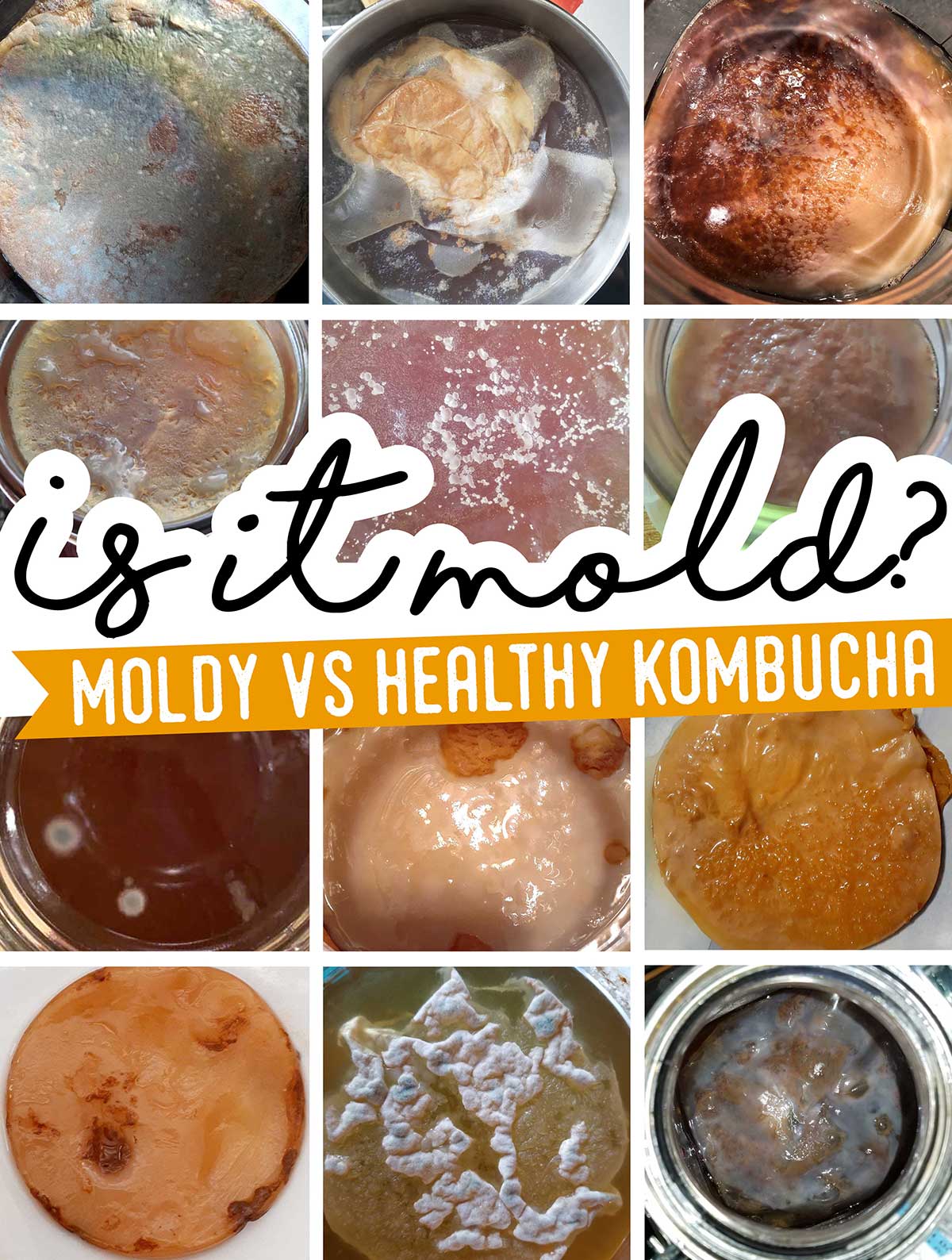
It’s every kombucha brewers worst fear…mold. But is it really as scary and world shattering as people seem to believe? No.
The thing is, kombucha mold is totally avoidable, and the chances or contracting mold are quite low if you’re brewing kombucha properly.
What is kombucha mold?
Kombucha mold is simply an overgrowth of bad bacteria or fungus. It isn’t much different than the mold that might grow on an old loaf of bread.
And while you shouldn’t drink any kombucha that has been in contact with mold (just as you wouldn’t eat that moldy bread), it’s not the end of the world!
What does kombucha mold look like
Though the chances are low, if mold is going to happen it will likely be in the first fermentation, when the kombucha acidity isn’t high enough to fend off the bad bugs. Once kombucha is bottled in the second fermentation, the acidity of the brew should prevent mold from growing.
While there are many different strains of mold that can grow – each with their own unique appearance – they usually have a few specific traits:
- Fuzzy or dry appearance
- Circular shape
- Colors range, but may be white, green, black, or blue
- On the surface of the kombucha (most mold needs air to survive)
Here are a few photos of kombucha mold for your reference. (Have a moldy SCOBY photo and want to include it in this gallery to help more people ID potentially moldy kombucha? Email me!)
(If your kombucha looks odd but it doesn’t look like mold, you could have kahm yeast.)
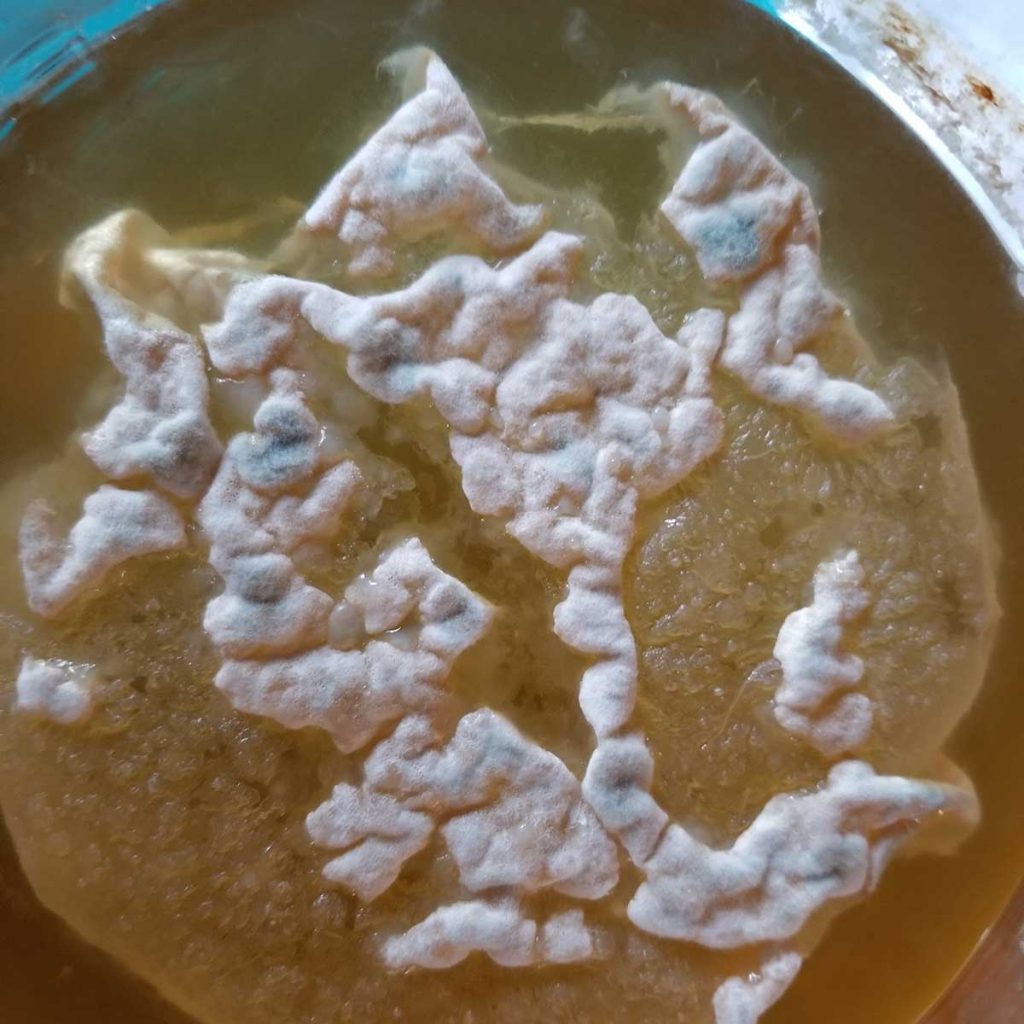
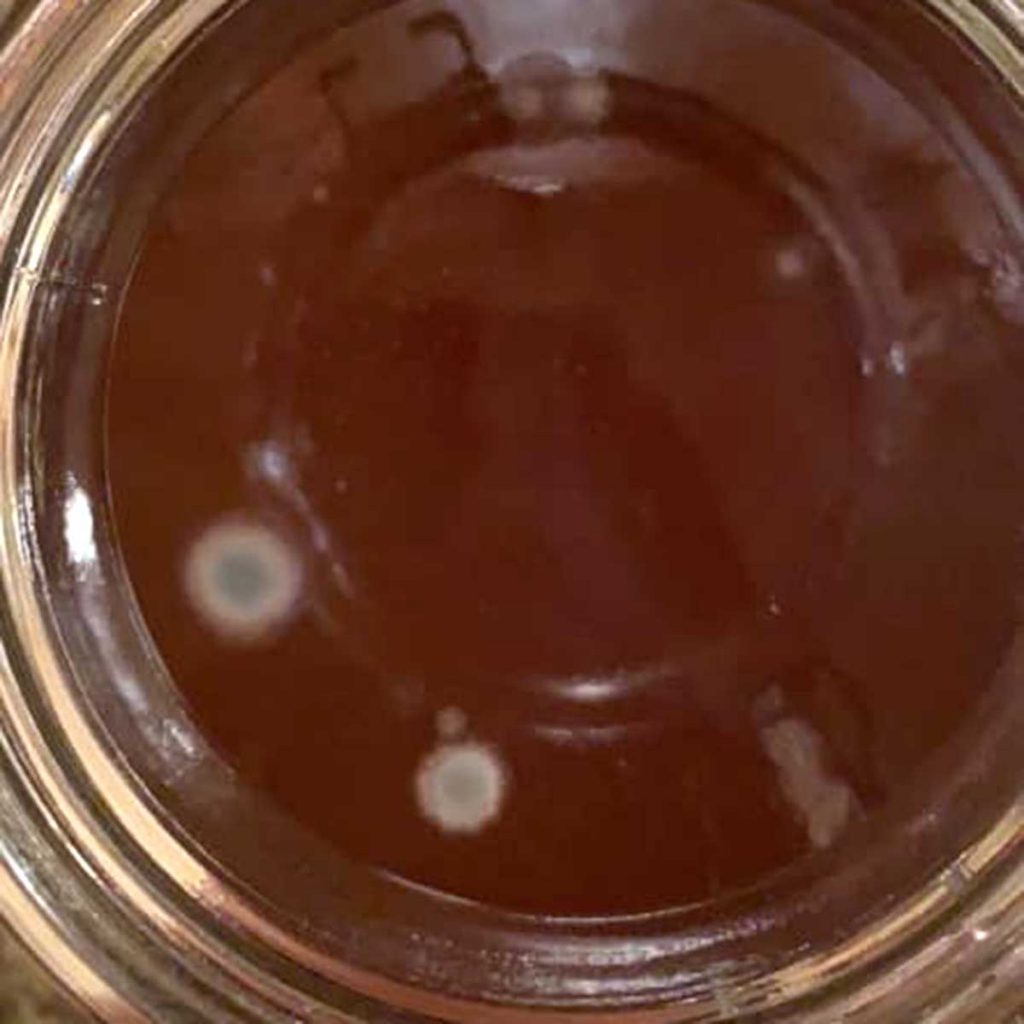
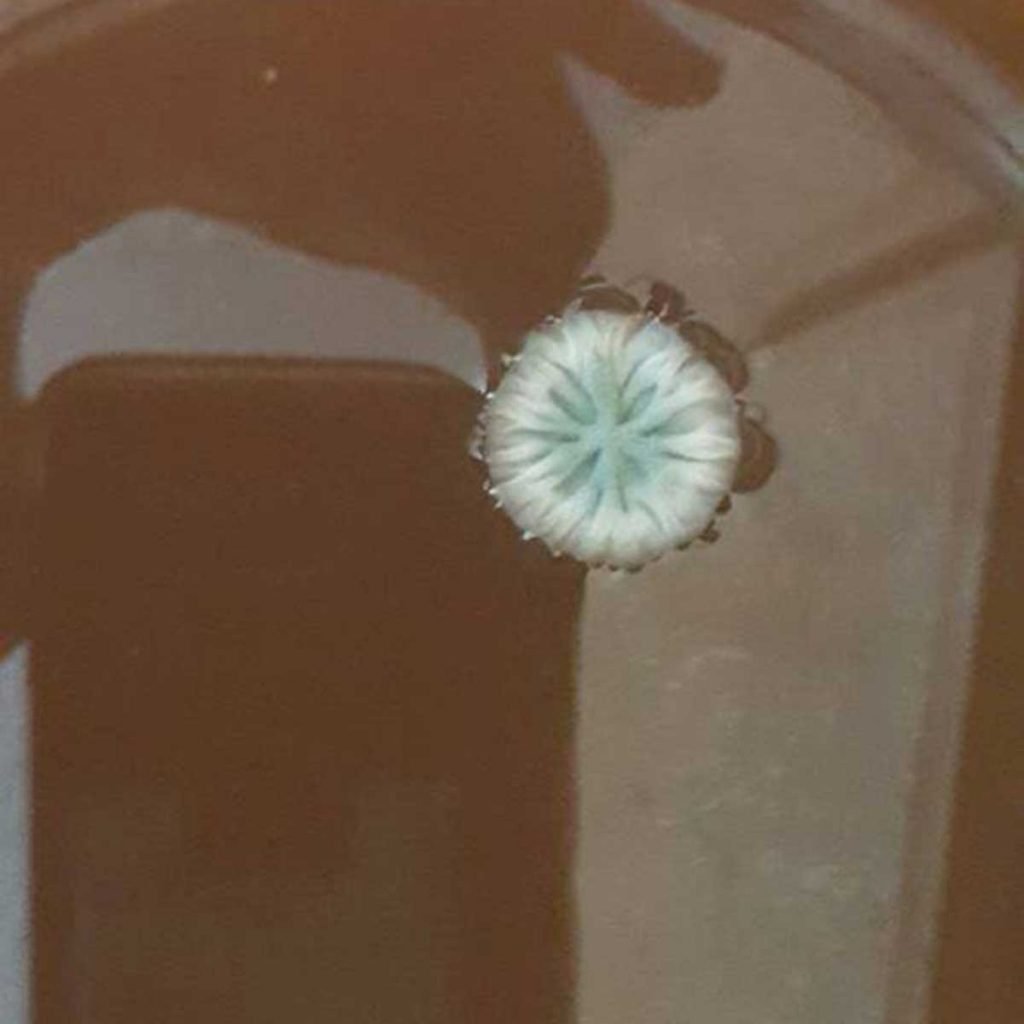


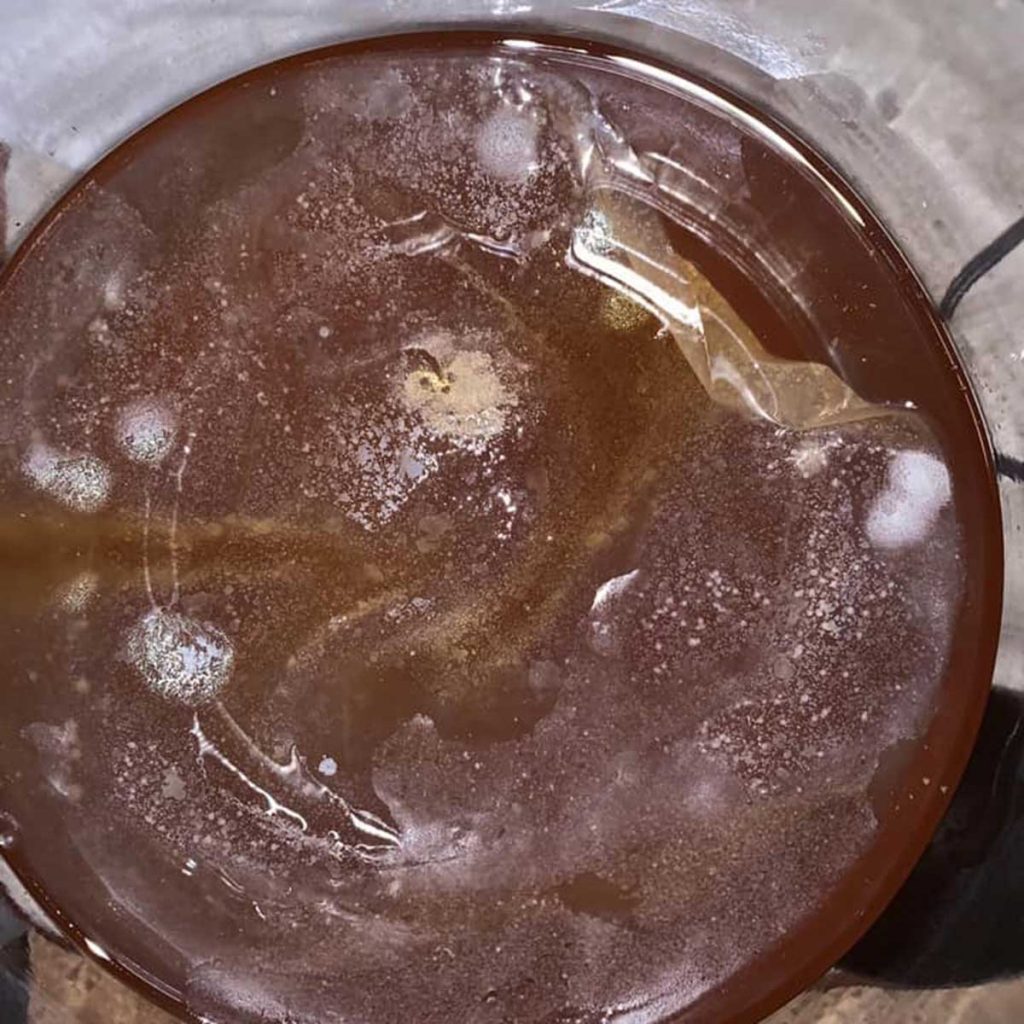

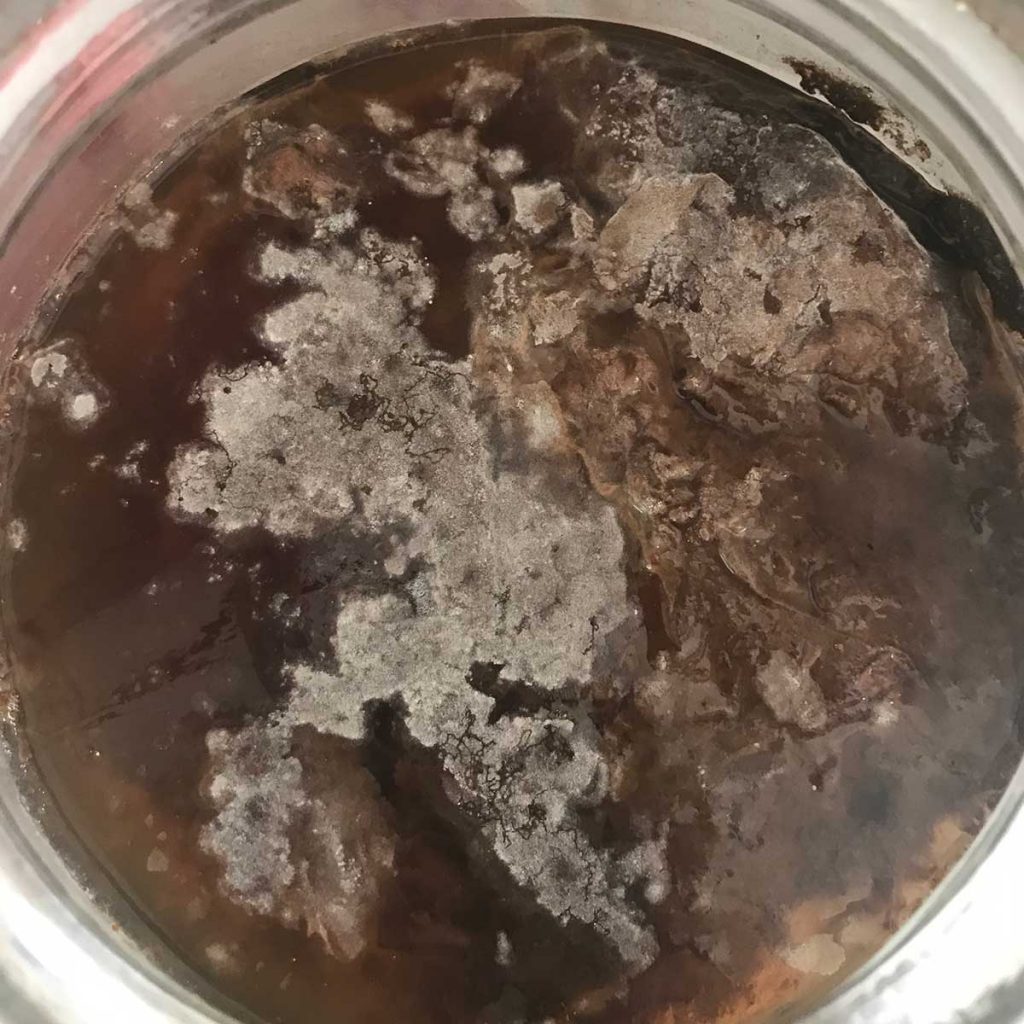
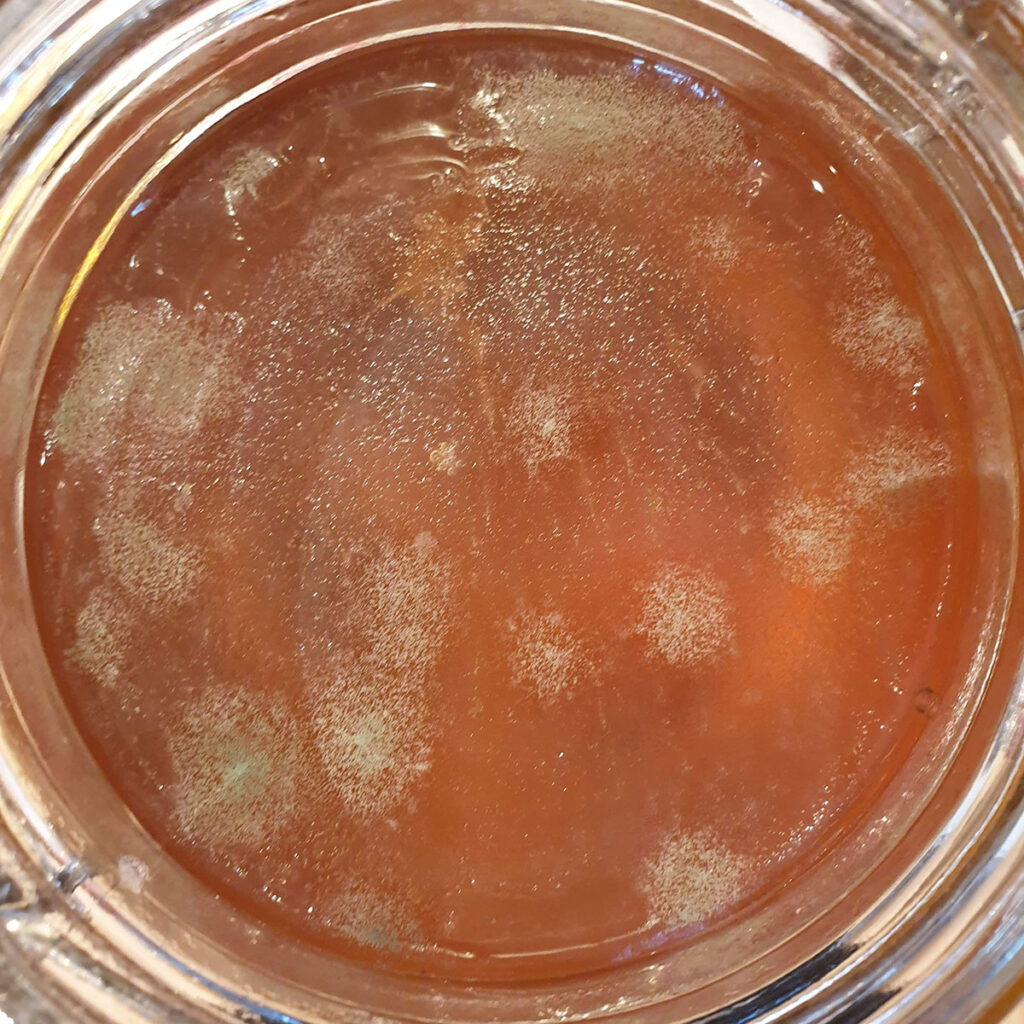

How to prevent mold in your kombucha
If you got mold, it’s because something went wrong in the process of brewing. Here are a few common reasons you may have got mold:
Not enough starter: If you didn’t use enough starter kombucha, or the starter wasn’t strong, the kombucha may not have been acidic enough to defend itself from mold strains. You can use pH test strips to ensure your starter kombucha is strong and acidic (should be between 2.5 and 3.5).
Temperature too low: If the temperature is too low where you’re brewing, or if you put your first fermentation / SCOBY in the fridge, the bacteria and yeast go dormant. This means they can’t acidify your kombucha, and mold may grow. Never store your SCOBY in the fridge, and ensure you store your kombucha somewhere warm enough to prevent mold.
Supplies not clean enough: Mold spores may have slipped in through your supplies, such as if you used a dirty sponge to clean the jar. Learn to clean your supplies to prevent contamination.
Used the wrong ingredients: Herbal teas and different sugars can weaken the SCOBY over time. Be sure you’re using the best teas and best sugars for kombucha.
Wrong place: Where your fermentation station is located matters! Airborne contaminants from garbage, compost, fruit bowls, or even other fermentation projects (like kefir or kimchi) can contaminate your kombucha. Ensure your kombucha is stored away from these.
What if I’m not sure?
The thing is, kombucha looks weird even under normal circumstance. So what if you’re not sure?
Just give it a few days! If it’s mold, it will grow to look like something in the photos above. If it doesn’t grow, it’s probably just normal, weird kombucha stuff.
Here are some examples of normal kombucha SCOBYs for your reference. Not sure if yours is moldy or not? Feel free to ask in our Facebook group!

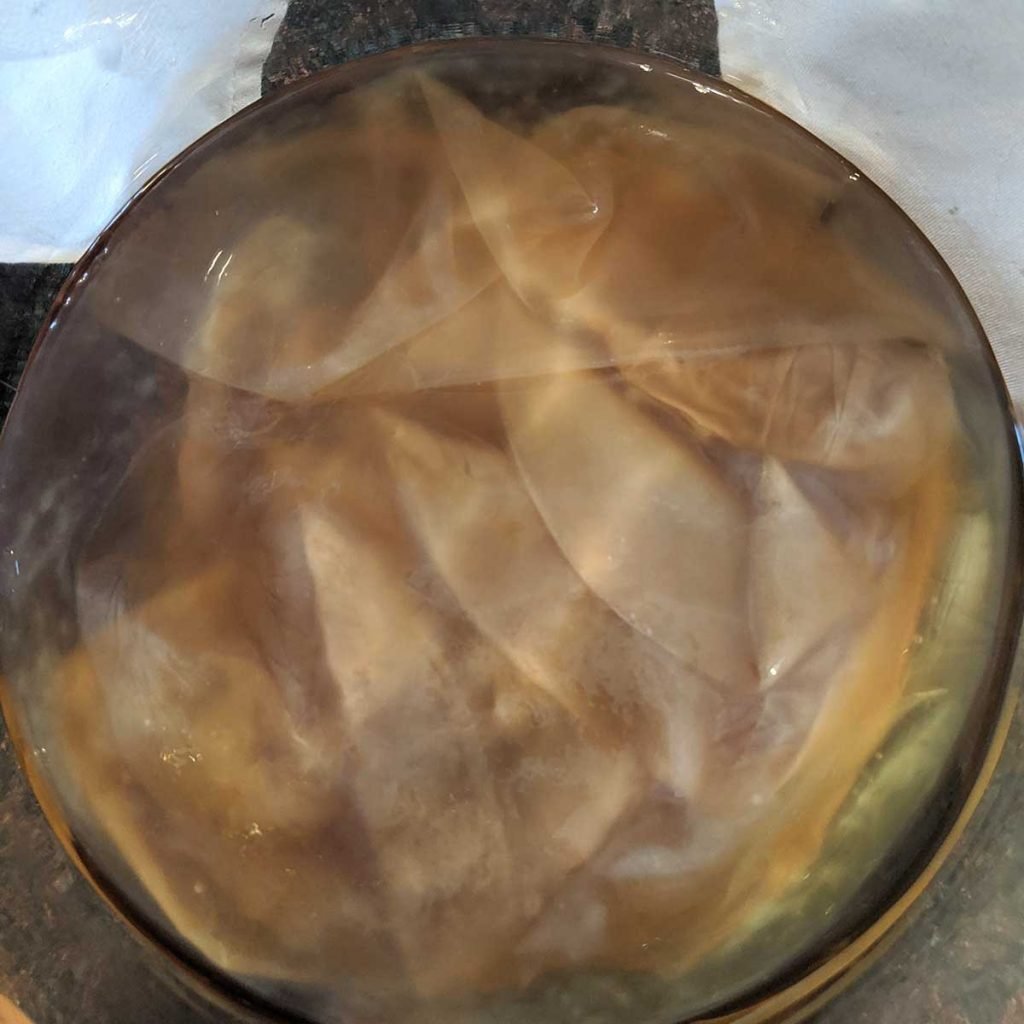
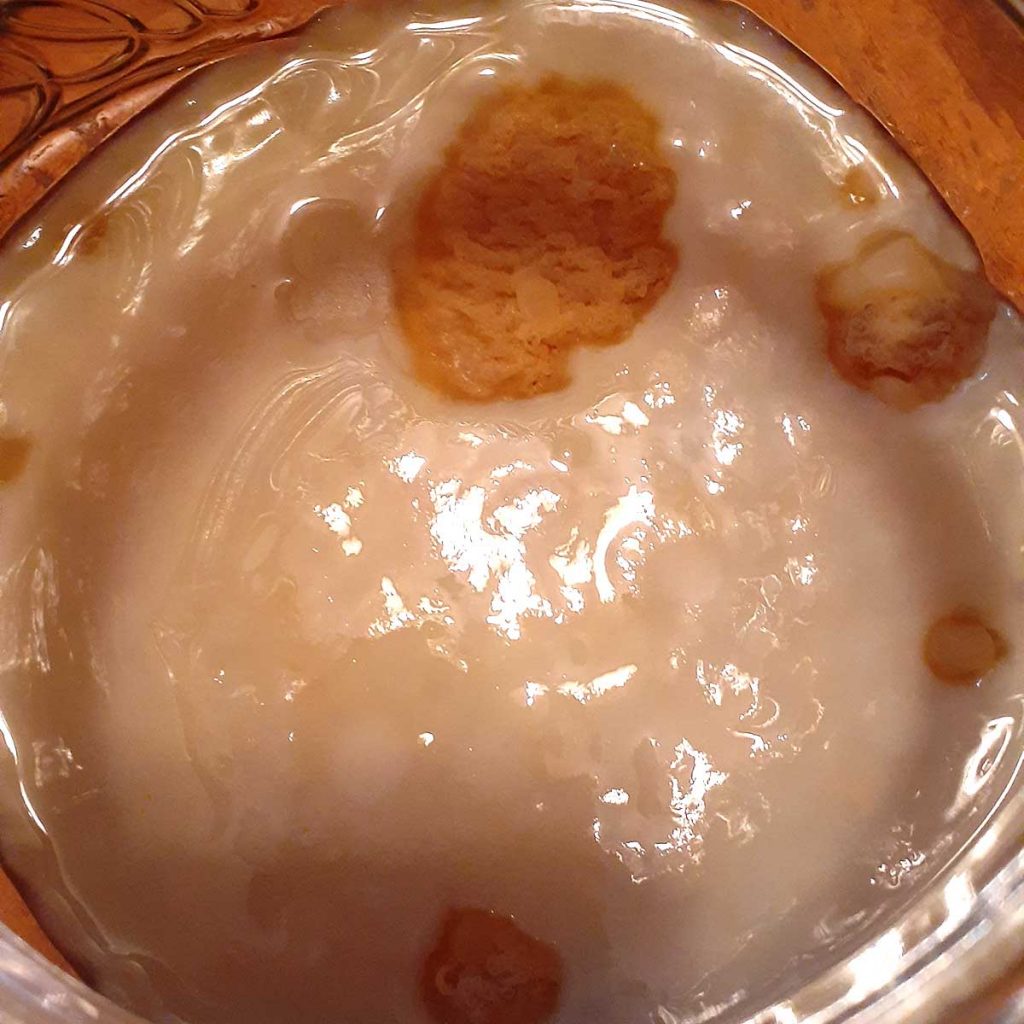
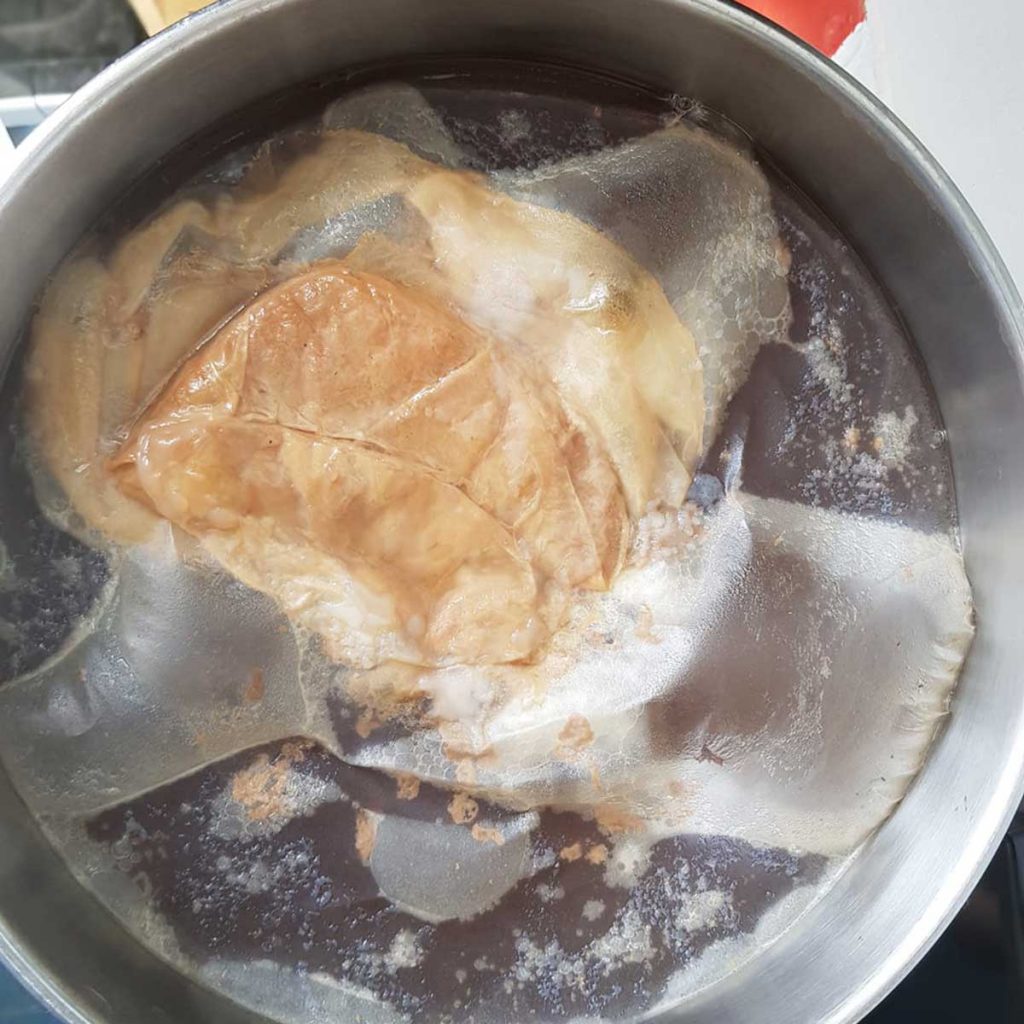
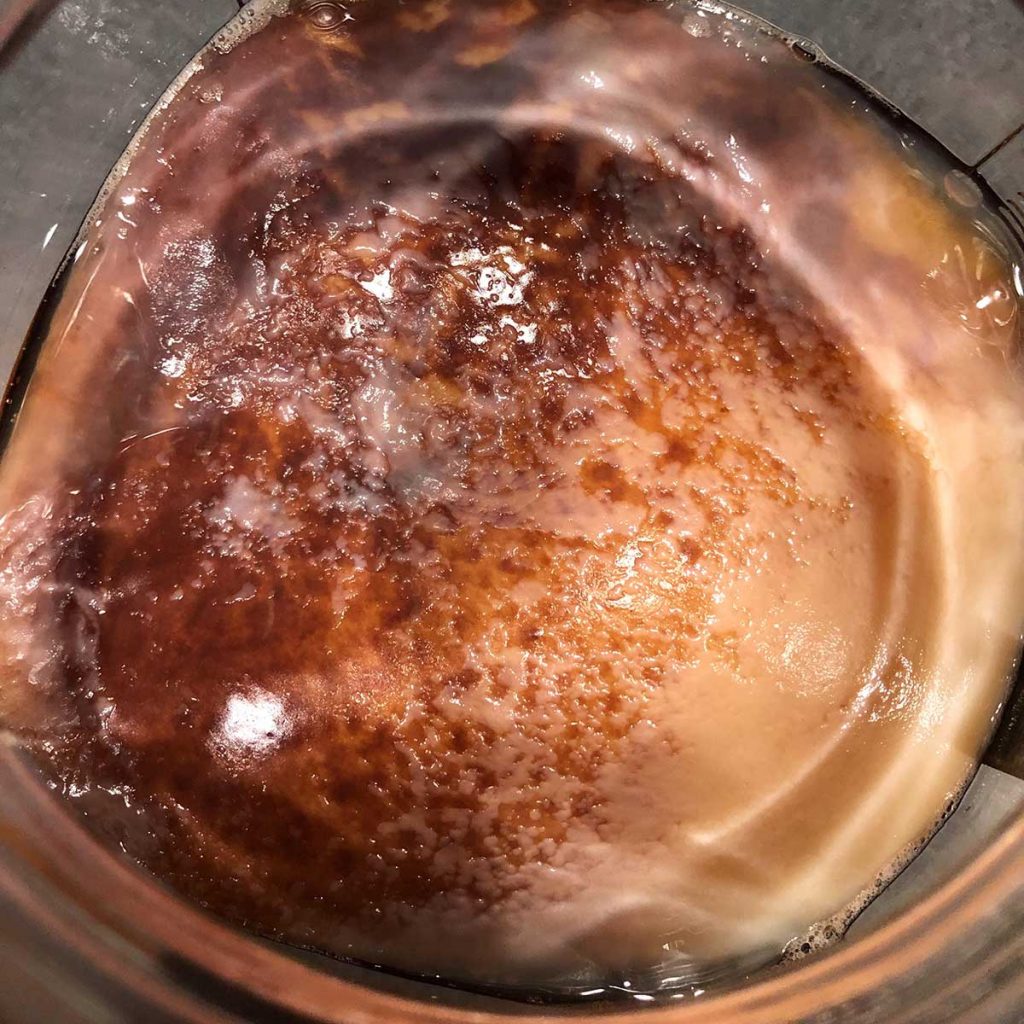

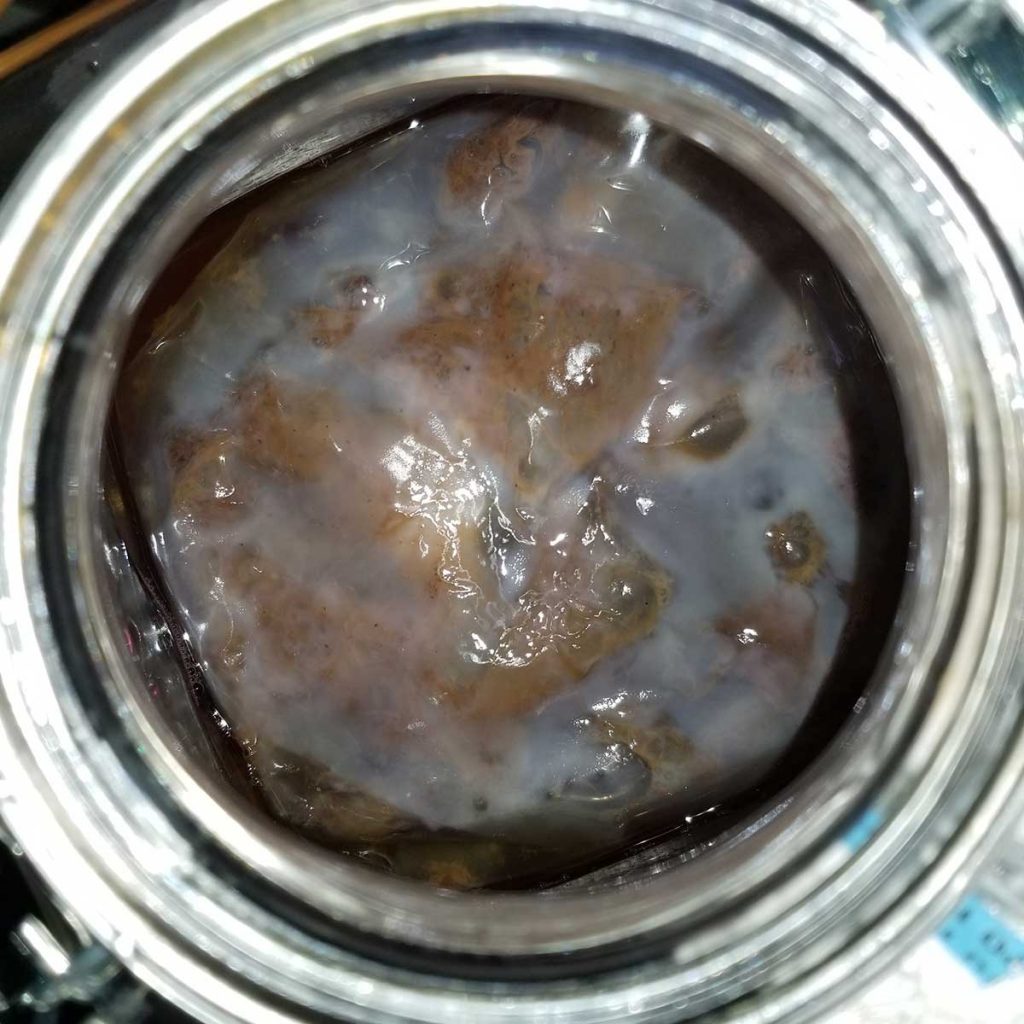


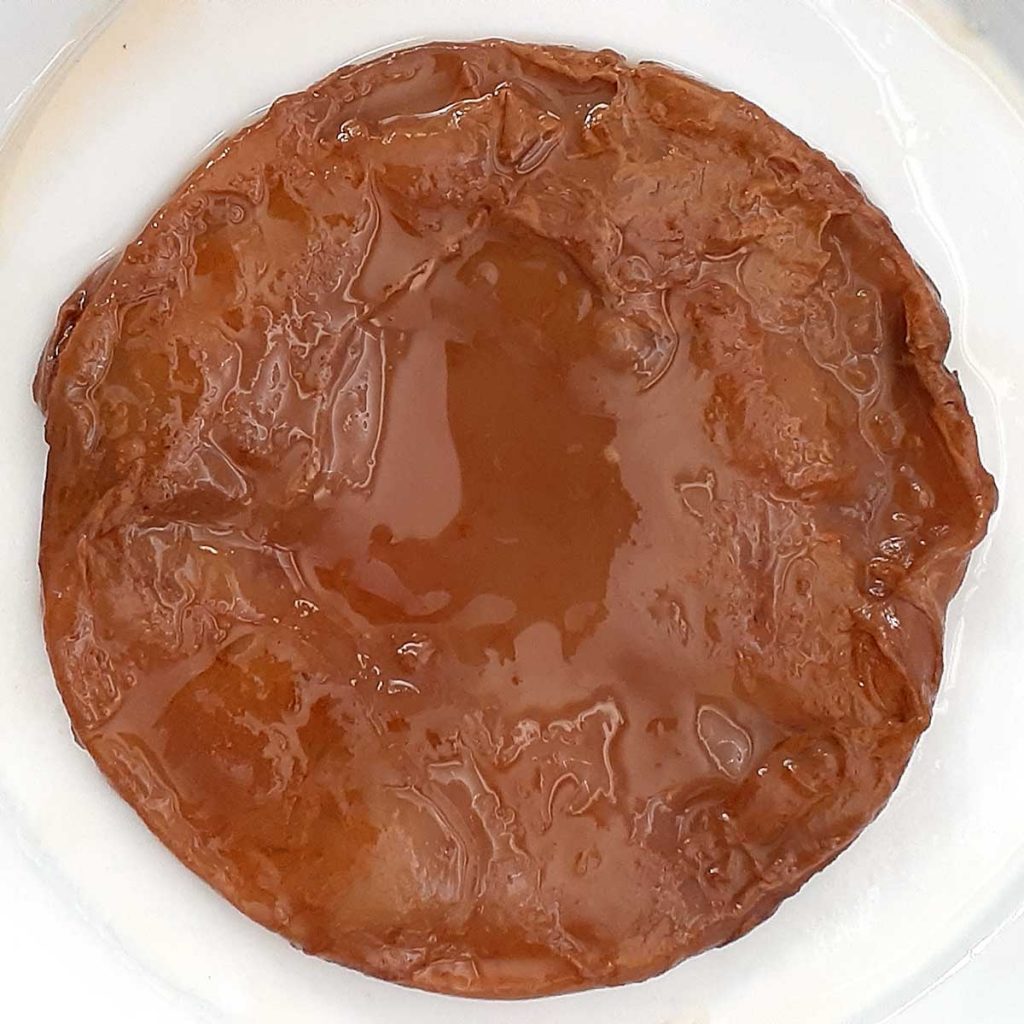
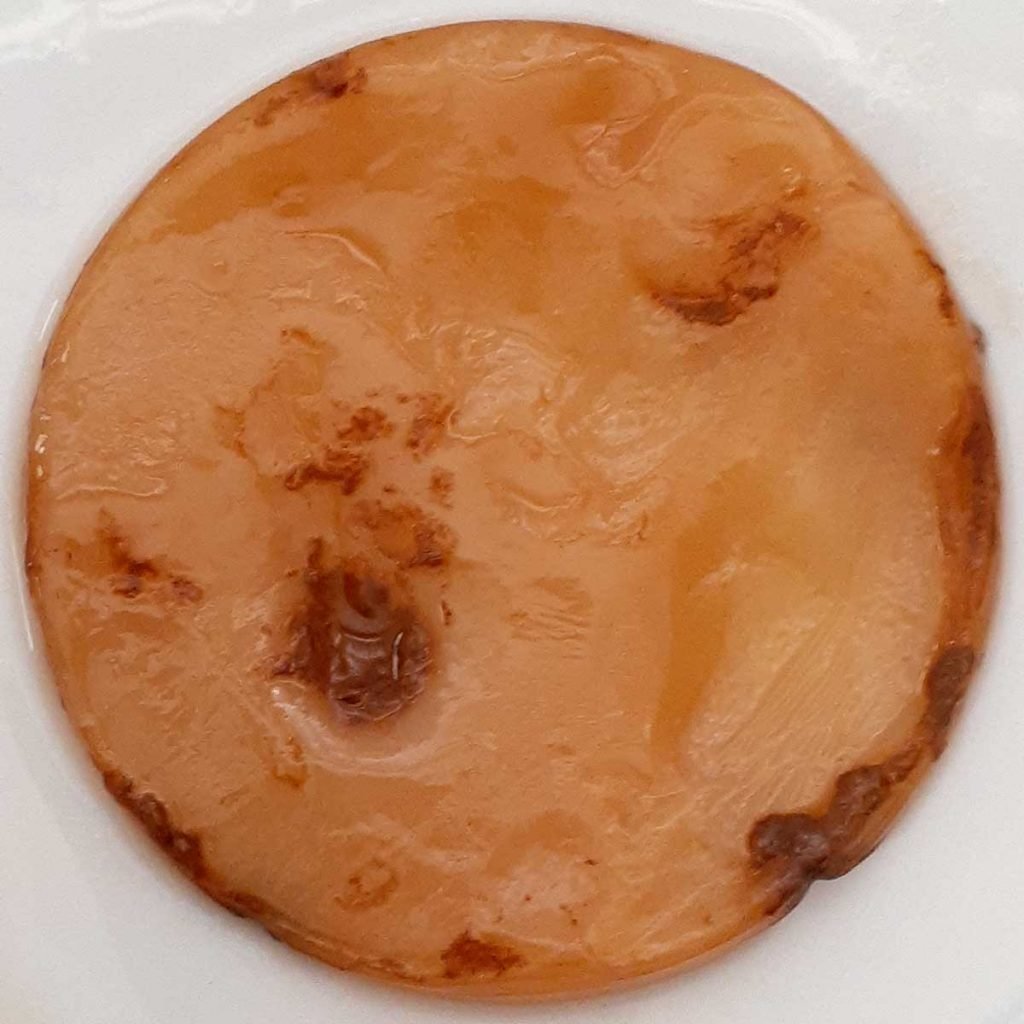
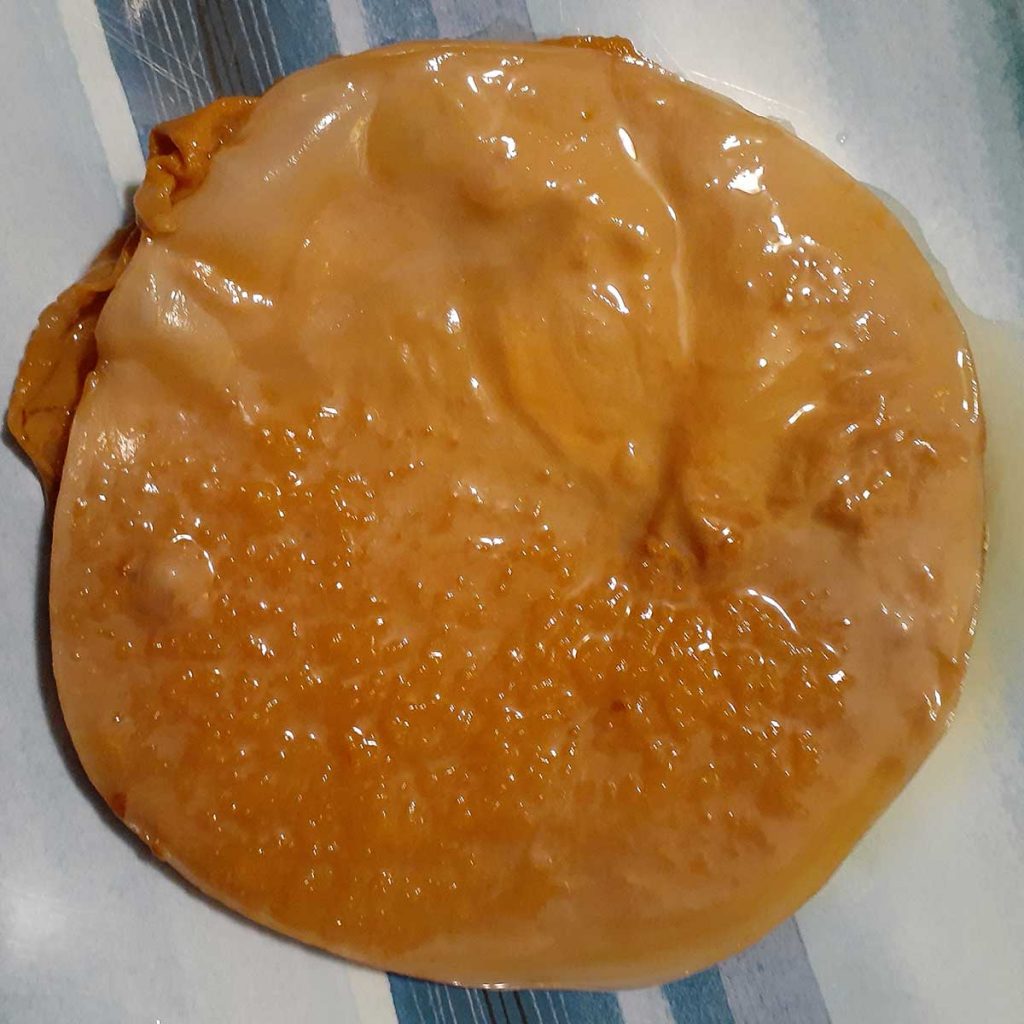
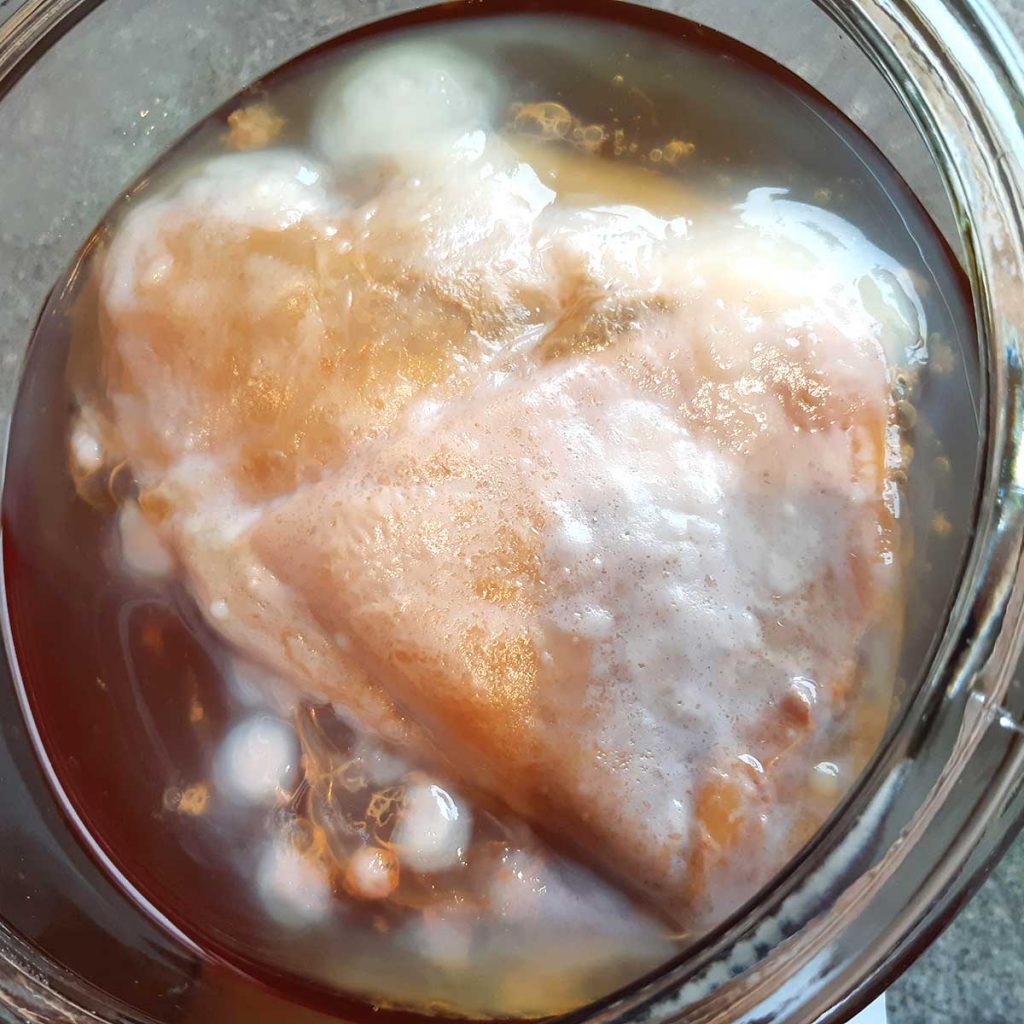
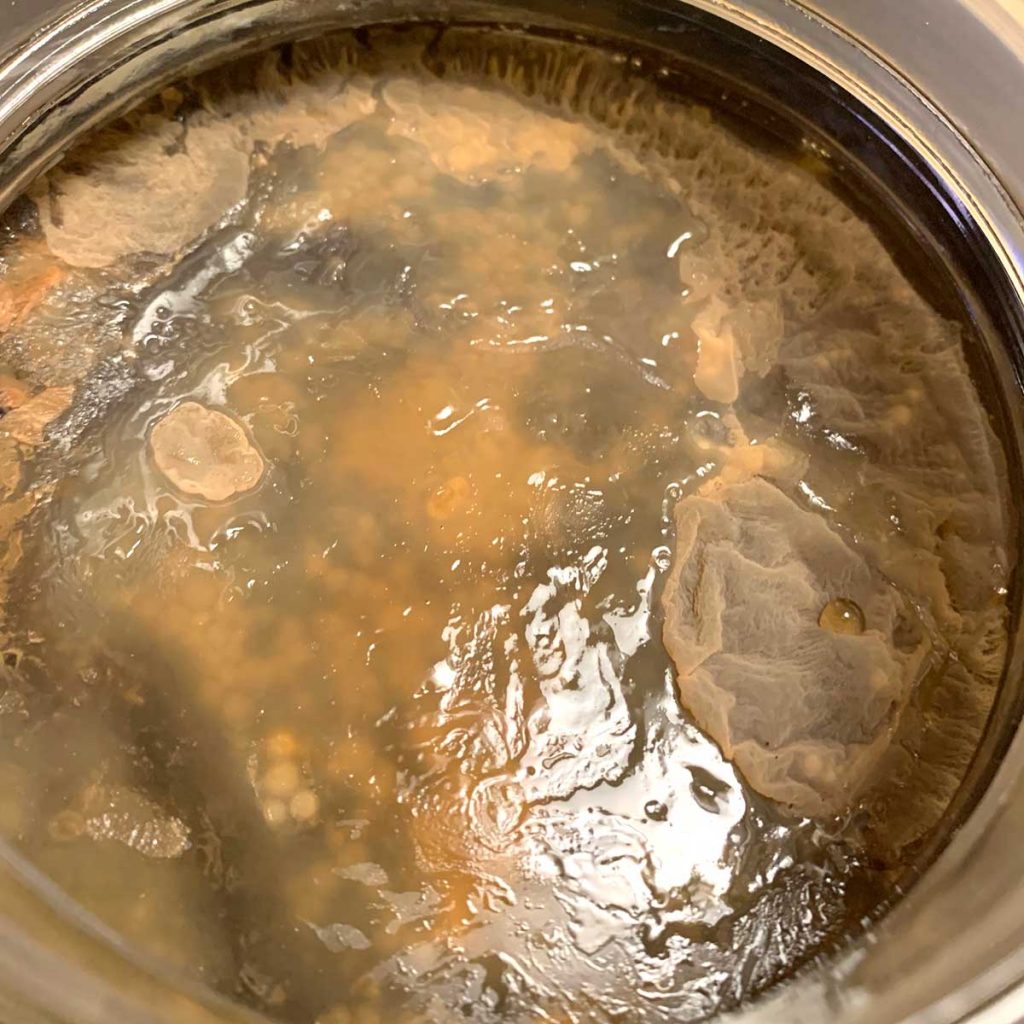
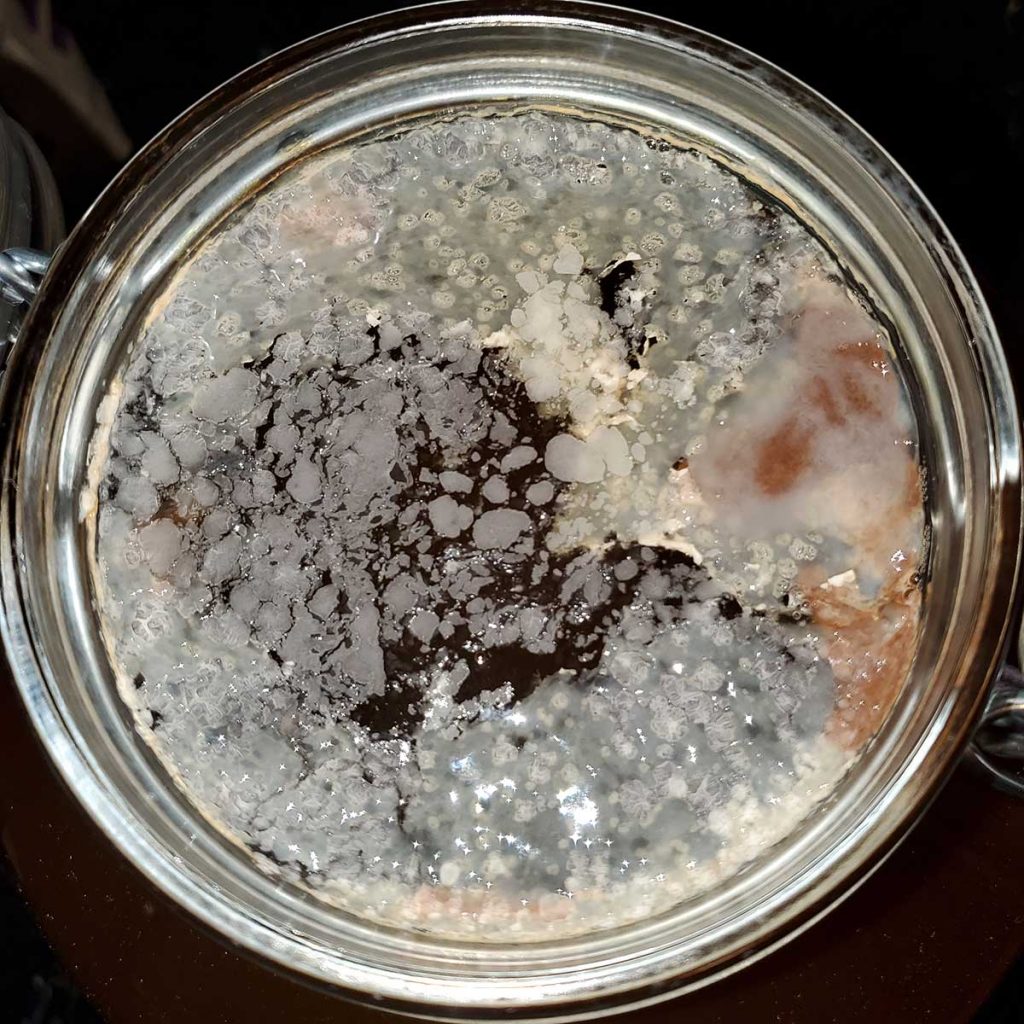
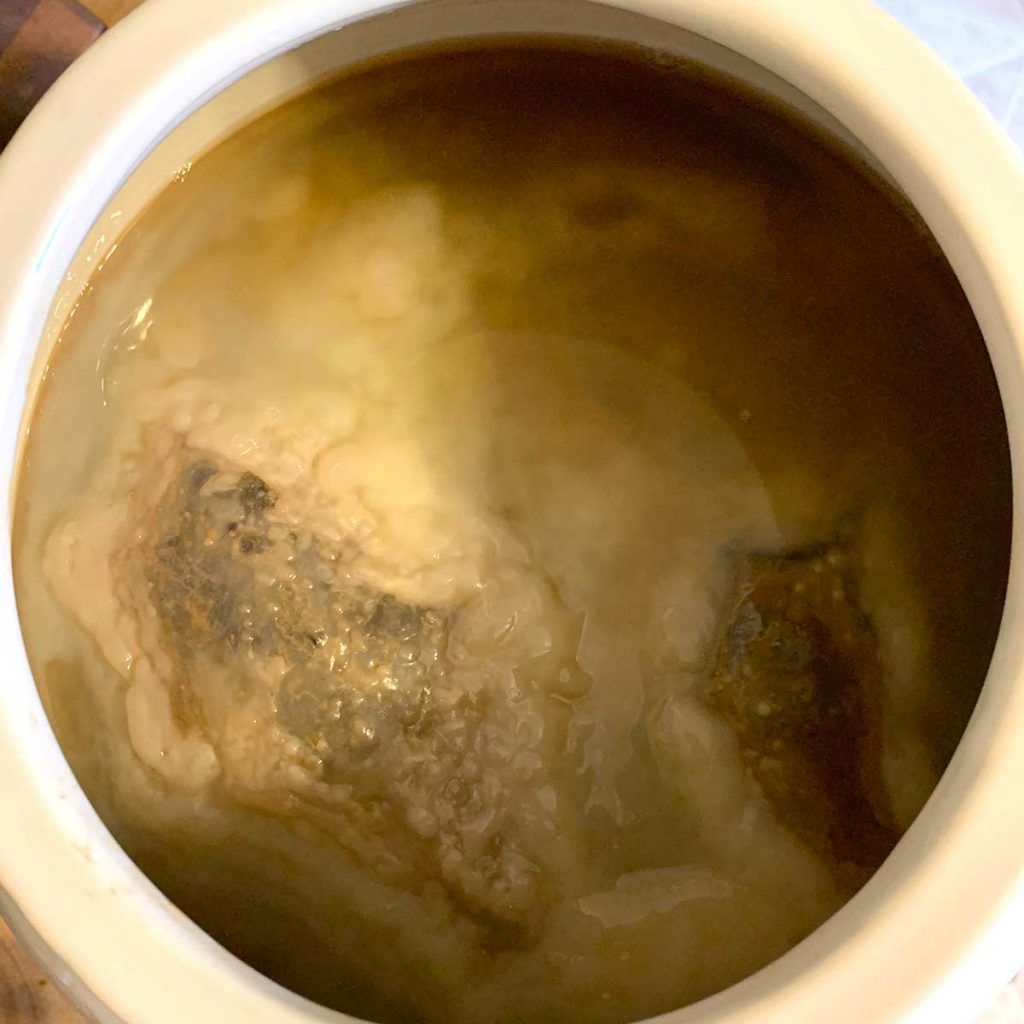
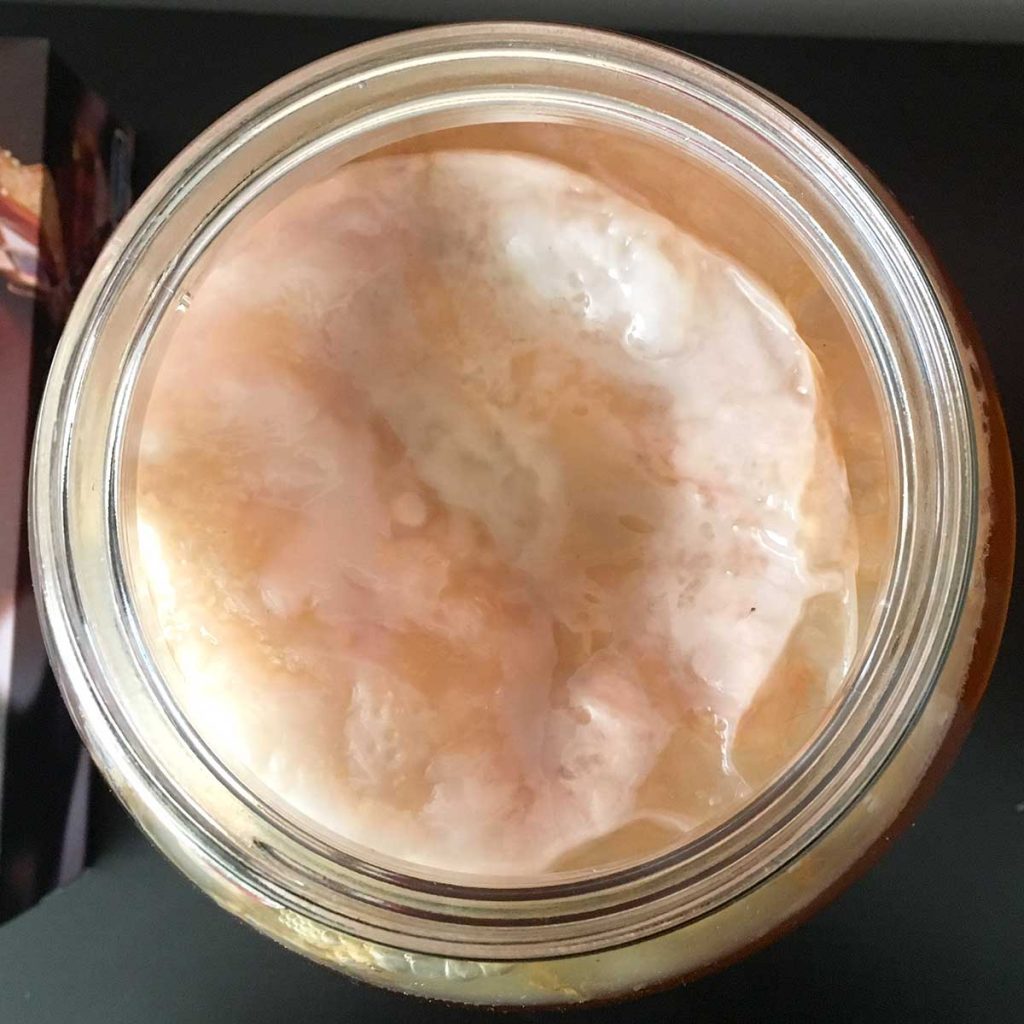

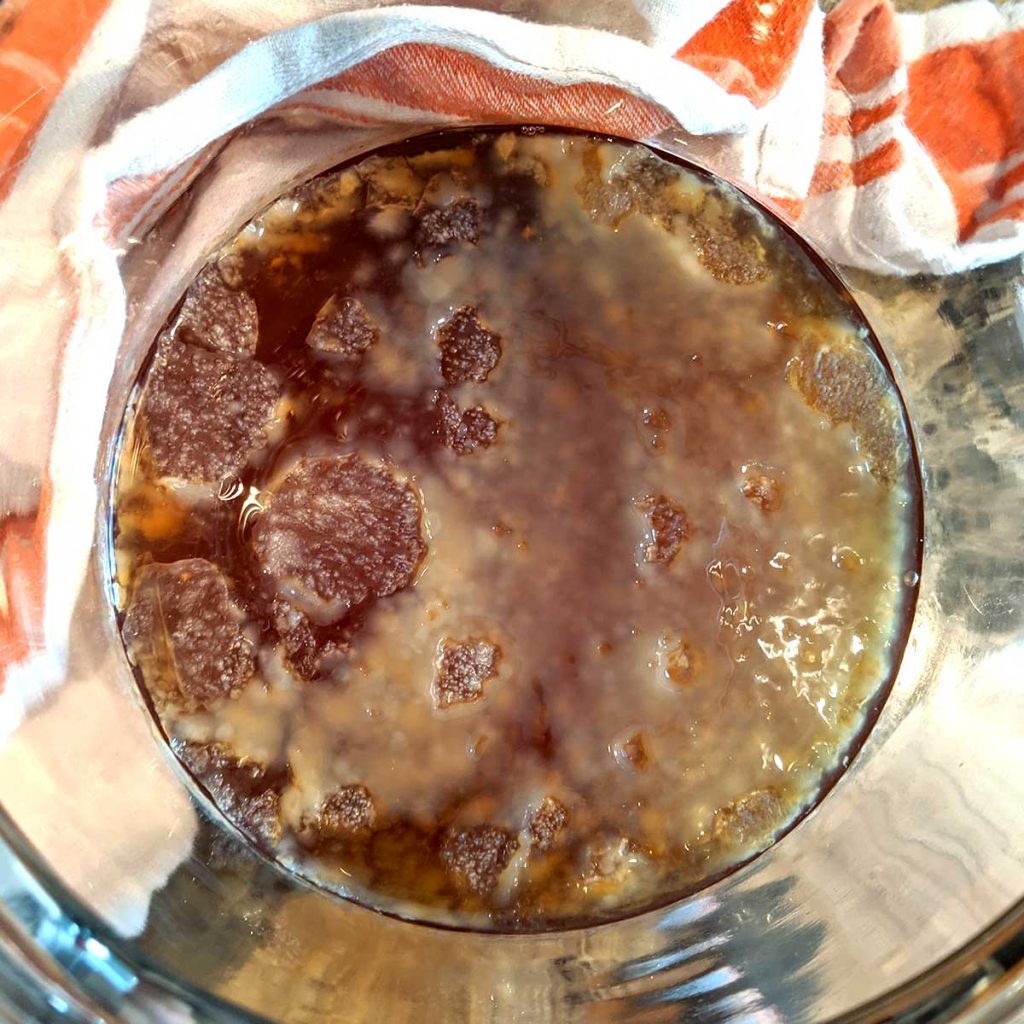

You got mold, now what?
First off, my condolences. Now it’s time to make your peace and throw it all away. The SCOBY, the tea, everything. There may be microscopic mold spores that you can’t see in the kombucha, so you’ll need to toss out the whole batch.
Next step, sterilize everything very well using boiling water and distilled white vinegar. (Here’s how I sterilize my kombucha supplies).
Finally, learn from your mistakes and move on. Figure out where you may have gone wrong so you can prevent mold from ever happening again. Can’t figure out what went wrong? Read the kombucha master recipe again closely in case you missed something. And feel free to email me with your questions!

When I bottled my last batch of Kombucha, I had to divide up my scabby….it was about 2″ thick. I made a new batch and it has been brewing for about a week now and a noticed a thin layer of Mold? new scabby? on top of my jar. It is kind of silver grey and a lot of bubbles around the edges. I took a photo but don’t know how to send it with this message. Thank you.
Sounds like that’s just a new SCOBY! 😀
Hey, I have a batch of kombucha I just did a few days ago. I have been checking it but today it had this weird grey/black/brown spot that from the side resembles a good ferment of sour dough start. But looks weird from The top. Smells good, but to nervous to test as I have test bad batches of ferments before and gotten sick. I was looking at the list of mold pictures and healthy one and non of them look like what is going on with mine. So I don’t know what to think.
Feel free to post a photo in our Facebook group to get some brewer opinions!
Thanks for your prompt reply,
I think I used to much tea like I said it tastes ok,
Question what is the best number of days before moving to the fermentation stage?
Thanks for your help,
That really depends on a lot of things, like how warm it is in your house and what flavor you like. Pellicle/SCOBY is ready at about 1/4 inch thick. Then you run the fermentations until the kombucha tastes good to you! Here’s our guide to making kombucha start to finish.
Hi
Good afternoon
I am brand new to this, ok I’ve brewed beer and cider before, I’ve started my first scoby question 1 it tastes ok but still looks very dark is that ok? I may have used to much tea,
question 2 how do I store the scoby after I complete the fermentation?
The color isn’t too important! And I would use the SCOBY to start another batch 🙂 Otherwise, here’s how to take a break from brewing kombucha.
I bought a kit with an organic scoby. After 6 days there’s a thin white film on the top. Is that mold? I think I made a mistake by using 9.5 alkaline water for my fermentation. I also used organic raw sugar. Did I use the wrong sugar too?
That’s probably just a SCOBY/pellicle forming! Here is our list of recommended sugars for kombucha.
I have some weird black thing growing on the side of my new scobby anyone experience this before.
Looks like scobby poop.
It’s probably yeast if it’s wet, but feel free to pop a photo in our group for some feedback!
My friend gave me a scoby and didn’t tell me not to store it the fridge! I don’t have all my supplies for my first ferment yet so I thought the fridge would be the best place for it. Did I kill it? Or will it be ok once it warms back up?
It should be okay, but I would take it out of the fridge now until you have all your supplies 😀
Hi Sarah! I may’ve missed this in the article, but do I throw out the SCOBY from my moldy Kombucha? Or can I cut off the top layer? Sorry, I’m a kombucha newbie 🙂
You’ll need to toss out the SCOBY unfortunately. Mold in kombucha can spread mold spores all around the jar, so it’s more likely to come back if you use the same SCOBY.
Hi
I am a returning reader and love the blog.
So I got a little scoby last week from my mom as a birthday gift. Today is the 7th day and it is weird looking, tho a little bubbly. So I applied for membership in the FB group to get some acknowledgment that it is doing just fine, because i cant enlarge the pictures with the good looking scoby. Hoping to be accepted. 🙂
I tried to make a batch of Kombucha but it went moldy, at the time I just took the moldy scoby out and some liquid from the batch and threw it away before topping the same batch up again. Now a few weeks later there is no sign of more mold growth, do you think it would be okay if no new mold seemed to grow?
If you don’t see any mold then I think it should be good to go!
I’m having a hard time trying to figure out if I have mold or not for sure! Is it possible I can send a photo to get a second opinion before I throw it all away?
Sure! You could also post a photo in our kombucha Facebook group to get more opinions.
Hi there – thanks for all the advice in your articles! Really helpful. When I took off the cheesecloth from my scoby jar, there were several fruit flies in it – do I need to throw everything away and start again? (Fingers crossed not!) Thanks Fiona
You might not have to! Here’s our article about fruit flies in kombucha.
Hi Sarah,
I’ve learned a lot from your website. Thank you so much for sharing your knowledge. As a first time kombucha brewer, I tried to join the facebook group about four days ago, and been waiting. Went back there today and it looks like the ‘join’ button was active again like I had never clicked it. Unsure but wondering, the question it asks for admin approval is whether I want to sign up through email for some tutorials. I opted to say no thanks instead of entering an email. Is this why I was denied? I again just requested to join and put in a fake email address. If it’s mandatory, then it should just say it’s required, that would be fine, but since they ask if I wanted to, I answered honestly. Anyway, would you be able to smooth my approval if you’re an admin there? I’d certainly appreciate it.
Hey Michael!I just let you in. Happy brewing!
Hi! I’ve been making kombucha for a few years now, and suddenly I have a problem I’ve never seen before – mold in the second bottling! I am very careful to keep things sterile, and normally I just chop up whatever – washed – fruit I’m using, and pop it into the bottles, along with a little sugar and the new kombucha. Last time, I decided to try pureeing the fruit first. It worked out ok but seemed like a lot of extra work for similar results so this time I just did my usual chopped fruit method. Now the fruit is all floating at the top, looking dodgy, and in one bottle…. The portions of fruit that are on-top are… Black! Obviously this will be disposed of, but… Whyyyyyy???? And is the entire batch doomed? 🙁
So strange! Is there a chance the fruit was moldy? That’s the only thing I can think of (besides the bottle being moldy)?
Hi Sarah, a couple of the normal scobies pictured look like they have small amounts of kahm yeast. (Dry, white/clear or tan layer on top of pellicle.) Is that in fact kahm yeast, and if so how does one deal with it? I just made a scoby and a ton of that stuff appeared… Thank you!
I need to research and write an article about this! I think I would probably rinse it off and add some store bought unflavored kombucha to bring in a better balance of yeast.
Hello Sarah, two weeks ago I saw spots on my bucha that I was pretty sure were mold. I put it on my I’ll deal with you soon list, but when I went back to it the scoby looked heathy. Does this mean I was mistaken, or could the culture have grown over the mold and its still contaminated?
If the spots are gone then it likely wasn’t even mold in the first place! 😀
I also tried making kombucha scoby for which I didn’t have any starter tea so I used apple cider vinegar. And the jar is off 1000ml. After trying it for twice i failed….as molds began to grow. Please help me so that I can successfully complete my project
I think the issue is that you’re not using starter tea to begin. It really needs that (otherwise you’re just making vinegar, not kombucha – it needs the right inoculation of bacteria and yeast to kick it off!) Here are some tips for where to find store bought kombucha.
Hi Sarah, if my kombucha top scooby has few small fish spots on top. It must be trown. But what about my second scooby in the same batch can it be used that is at the bottom of the brew? Thank you
You’ll need to throw away everything that was in that jar, all SCOBYs and liquid included. Sorry about that!
Hi! I came back from a longer than planned vacation and I had a beautiful new scoby forming on top with my mother sitting at the bottom when I left. I fed it some sweet tea but no vinegar and left for 7 days. As I came back, I checked, and to my horror, what looked like mold to me, was sitting on top of the newly formed scoby. 2 White spots on my top layer. I figured I would just get a new mother from a neighboor and threw out the top layer, keeping the mother at the bottom and adding vinegar just for testing purposes. Now, I’m reading the Q&A and seeing that mold would grow back. I’ve since had two new healthy baby scobys in my brew. After 3 days I moved it and that baby went down with the mother and 48h later I have a new one forming on top. So I’m kind of thinking I may have overreacted, how would I know if mold was there in the first place ? If it were to grow back say.
I tried to include as many examples as I could of what mold looks like in this article, but feel free to post a photo in our Facebook group to get some feedback from other brewers!
It’s been 4 or 5 months since my last batch and the scoby on top of the pile that have grown has seriously black mold spots and white mold sticking to the sides of the jar. I’m a newbie in growing kombucha but made about 6 successful batches before.
I am presuming the top scoby should be discarded and the jar cleaned/sanitzed. But will all the other scoby’s underneath also need to be discarded or could they still be usable?
You should throw out everything in that jar – the mold probably gave off spores which will contaminate any other batch you put those SCOBYs in.
Can anyone help a first timer?
I have what looks like egg drop soup but at the bottom of the jar. Top of the jar is clear, no mold like in the pics. Been brewing for 21 days now. Tasted it and tastes just like sweet tea to me. Definitely see a new scoby that has developed. Did I do something wrong? Zero carbonation.
Sounds like yeast strands to me! Feel free to post a photo in our Facebook group to get some brewer opinions – Kickass Kombucha Brewers.
Hi!
I can notice small brown “breadcrumbs” (doesn’t look like scoby jelly, but looks more hard like small rocks) at the bottom of the brew. I stored my scoby a few days, had the big jar washed etc, and was about to make a new batch with tea when I saw this. What could that be?
Maybe it’s tea leaves that slipped in?
I made some kombucha and on the second fermentation there was white dry stuff on top. I removed it and it never grew back but was it mold?
It was probably the beginnings of a SCOBY! 😀
Hello! I am brewing my first batch of kombucha but after almost 4 days i se some white spots in my kombucha. I can also see the small scorby formation. I bravely throwed the small spots parts but what if it’s mold?I am not sure if it’s mold but if it’s mold won’t it grow again? Could it also be the scorby i am so confused i don’t know what to do. I actually added some more starter tea into the vessel so it’s more acidic. And just realized it’s winter here so i kept it in the cupboard. What should i do?
If it’s mold it will grow again. But feel free to post a photo in our Facebook group to get some feedback!
Hi…..on my first batch of kombucha I noticed a few black spots on one of the Scoby when I went to bottle it. I had several others in same jar that look fine. I threw away the one with a few black spots. Wondering if it was mold. No fuzz. Didn’t look like any of the pictures here. How could I send u a pic???
Feel free to post a photo in our Facebook group to get lots of feedback!
Thanks for your site. I have done several rounds and have discarded a few fearing they were potentially moldy – but am thinking they are just normal. I do tend to get some pretty serious yeast blooms – is that temperature related and sometimes the beautiful scoby doesn’t come to the top even with a gorgeous new thick one on top. I’ve left some until very vinegary trying to wait until the beginning scoby floats. Any guidance on this that you can give???
The SCOBY doesn’t need to be floating – it’ll swim all around your jar and that’s okay. The yeast variation is temperature dependent, but it sounds like you probably don’t have mold!
How do I send a pic?
Feel free to post on in our Facebook group, Kickass Kombucha Brewers!
Green things hanging from the scoby are yeast? Green things? Could you verify that you did intend to say that is yeast?
Yes, greenish/brown things hanging under the SCOBY are very likely yeast. Feel free to pop a photo in our Facebook group if you’re not sure! Kickass Kombucha Brewers.
Hi. I am quite grateful for this site you have. I am a beginner, with my first SCOBY given to me as a gift. Only 4&1/2 days into my first batch, I peeked and it looked like Mold. I have Two jars full, one looking moldy the other not, but you answered ALL my questions via the site and the Q&A at end.
Thank you for this. You are nice.
kth
Happy to hear this content has been help for ya! Feel free to pop some photos in our Facebook group if you want some other brewer opinions on whether or not it’s mold.
Hello, I’m on my second batch of kombucha and the SCOBY has a clump of dark green stringy tube like things hanging from the side of it. It looks like algee. Is this ok?
Yep that’s okay! Just strands of yeast 😀
Hi Sarah! I just made my very first batch of kombucha and I am in the second fermentation stage. I got a scoby and starter from a friend to start my first fermentation, and at the end of 8 days, I had a beautiful new scoby on top! A few questions: for my second batch, I put the initial scoby and my new scoby back in my jar, along with starter liquid. Is it correct to use both scobys for new batches? Second, my new scoby is no longer floating on top, but has sunk to the bottom and is resting on the old scoby (which is quite misshapen and has a lot of brown spots). Is it okay that they are both in the bottom of the jar? Will my new scoby still grow in thickness?
Hi Corianne! It’s okay if your SCOBY(s) sink, that’s normal. And you can use both SCOBYs in your next round of F1, or split them up to have two rounds going. It sounds like you’re doing everything right though!
Hi Sarah, I’m trying to make my first scoby and it’s been two weeks, half of that I had it in a dark utility and I then moved it to a hot press because there’s absolutely no sign of growth, even after putting it in warmer conditions. All the residue is at the bottom, it smells yeasty, there’s some bubbles coming from the bottom but there nothing growing in it not even mold ????
Hi Gráinne! It sounds like you may need to retry using a different starter (unflavored) kombucha. Also be sure not to add the starter while the tea is hot, which would kill the bacteria and yeast.
In my bottled, second fermentation, there was a tiny slimy blob in each one, under the surface. I bravely removed and drank the very delicious buch, but now I’m wondering, was that mold? It kind of looked like little scoby things, but that’s unlikely after only about four days in the cupboard before refrigeration? Obviously I’m doing fine, so whatever it was it wasn’t fatal:-)
Those blobs are just baby SCOBYs forming! We get them in almost every bottle of F2 – nothing to worry about! I like to throw them into smoothies 😀
Hi I tried second ferment with brewed coffee and a tiny bit of sugar.
After 3 days ready to strain and put in fridge I noticed a couple of white spots on the surface mixed in with the dregs. It’s hard to tell if it was a bubble cluster as around the rim there was alot of bubbles. Not sure whether to ditch it.
Hi Ella! If you have a photo, feel free to post it in our Facebook group to get some feedback from other brewers 😀
Can the second fermentation get all bubbly looking at the top? A little bit brown and has stings coming down?
thanks for all your tips!
Yep that’s normal! 😀
Hey Sarah!
Just a question. I’m doing my first fermentation and I have another Scoby growing on top. There seems to be quite a bit of bubbles under near it and to the side. And orange/brown film under it as well. Is this normal! Thank you 🙂
This is totally normal! 😀
Hello Sarah, i am fairly new to the making of kombucha but because i got a stunning scobi from a friend, my first batch was TERRIFIC! But, I kid you not, I got a little dizzy after drinking it. Could there be alcohol forming during the fermenting? And then, whether your answer on that is yay or nay, can it be bad for you to drink to much kombucha? Meaning would my constitution rebel and produce some unhealthy reaction..?
Just saw that you read my post on kombucha side effects – looks like you found all the answers there! So great that you’re liking the buch!
Hi there, I made my starter 15 days ago and the scoby is very thin and doesn’t seem like it is growing anymore. I leave in Canada and it was probably too cold as I had put in a dark cupboard . For the last 5 days I have put I on a warming mat and left in out of cupboard and the scoby did form but it is very thin. Should I leave it longer or is there anything I can add to it to help it grow thicker or is that necessary? I appreciate your help.
Hi Joann! It will just form more slowly in colder temps, but the heating pad should help with that. Besides keeping it warm, there’s not a lot you can do to speed things up (aside from adding a bit more unflavored kombucha, if you have access to it). Try to get it to at least 1/4 inch before using it to start your first fermentation. It’ll get there!
Thank you for sharing your kombucha knowledge and recipes.
I wanted to ask if I can reuse the jar from my 1st ferment without washing it. So basically after 1st ferment is finished. Move scobie and culture (starter) in bowl. Boil water and prepare tea in original jar.
Thank you, Margarita
Yep! As long as the inside of the jar hasn’t been exposed to any germs (like dirty hands or sponges), then you should be good to reuse it without washing. This is what I do, and I generally give it a thorough washing ever couple months (and in fact, I usually just leave the SCOBY + starter tea in the jar to prevent contamination, only pouring out the kombucha that I want to bottle and leaving the rest in the jar).
How long does a batch last in my refrigerator ?
Store bought kombucha has an “enjoy by” date.
Great question, Corinne! Kombucha will last for many months in the fridge. The “enjoy by” date is required for store bought food products, though kombucha virtually doesn’t go bad (if bottled correctly). It will continue to ferment very slowly in the fridge, so the flavor may become more sour over time. 😀
I have mood on the top of my scooby, can I wash it off and start over? Do I need a new scooby? Can I peel that top layer off the scooby?
If you have mold you should really toss out the whole batch – those spores can spread and cause more mold later on, unfortunately.